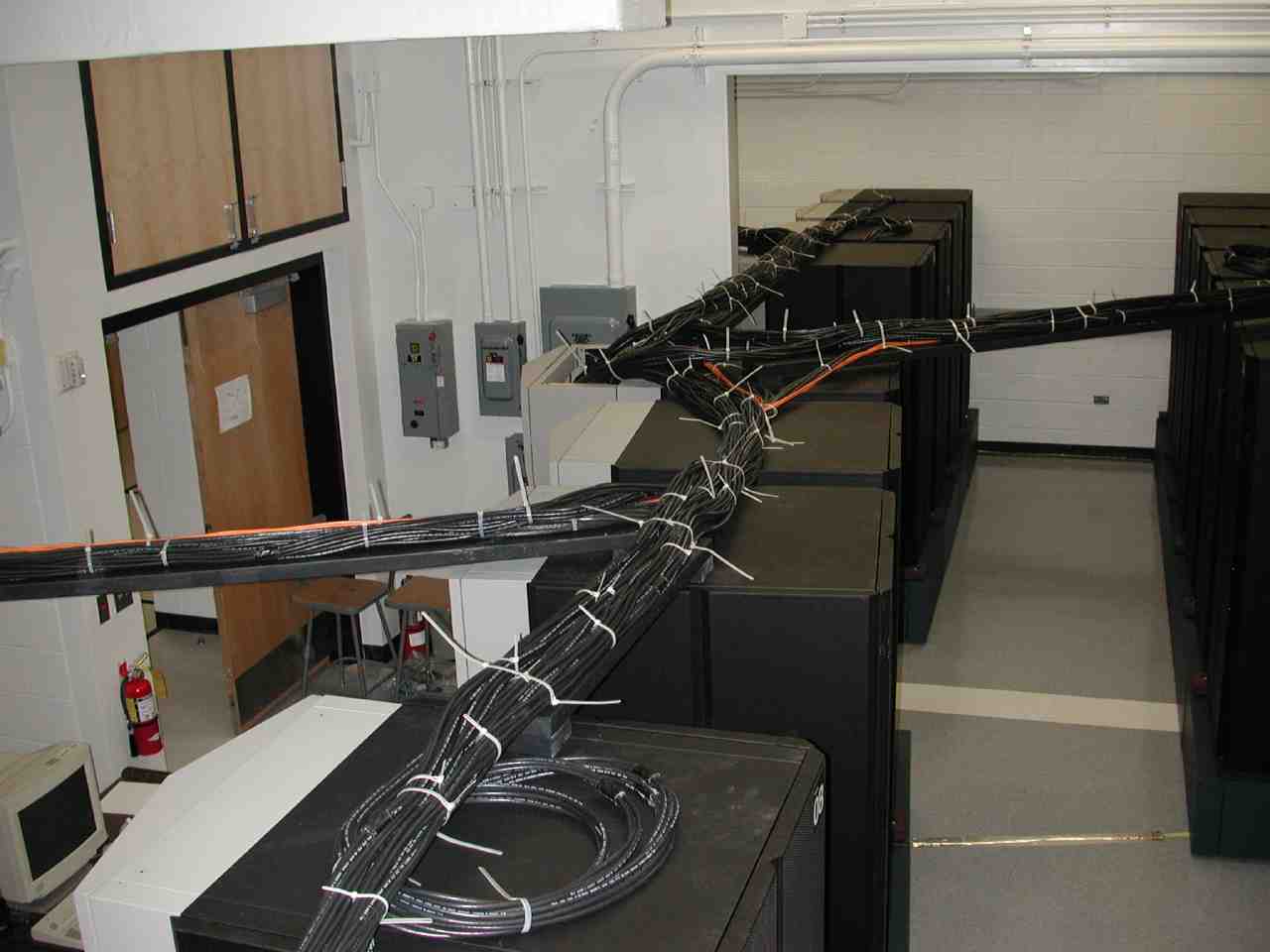


Laptop and desktop network configuration
|
Configuring X-windows (Windows)
The University and the Physics Department have a license for the X-Win32 software from StarNet Inc. This software can be installed on Windows computers and allows software that runs on other computers, usually UNIX or Linux computers, that need to display graphical output to send this output to the Windows computer.
Mac's do not need extra software as teh X-windows capability is built into the MacOS.
You must obtain the installation software from QTP or Physics computer support. Once you have the software installed, there will be a new icon on your desktop and a new item X-Win32 in the menu "Programs".
Start the X-Config application.
- In the right hand side of the panel, you will see "New Session" and under neath a button "Wizard...". Click that button to create a new session profile.
- Enter the name of the session. This will help you identify the session with all its settings in your menu of sessions. From the list of session types, select "ssh".
- The next panel asks for teh host name or IP address. For example: crunch.qtp.ufl.edu.
- In the next panel you enter the username on the remote host. You can also enter the password, but that is not recommended for security reasons as someone who breaks into your Windows computer can then gain further access to this host as well.
- The final panel asks for teh command to run. You can type in a command. To create a login shell click on the operating system from the list in the panel. For crunch.qtp.ufl.edu, select SunOS (Solaris) and the wizrd will fill in the correct command.
- Then click "Finish" to complete the definition of the session.
Now you can "Launch" a session. If you did not save your
password, which is highly recommended for security
reasons even though the convenience is tempting, a
window will pop-up requesting for the password. Then an
xterm window will appear on the remote server defined in
the session. You can verify that the X windows protocol is
set up correctly with
echo $DISPLAY
If this shows something like
localhost:13.0
everything is working fine.
Now you are ready to initiate graphical application software on the server, such as Xemacs, Maple, Matlab, etc.
After this first-time use, you can start the X-Win32 application from the "Programs" menu or by double-clicking on the icon. Then a littel icon appears in the taskbar. Right click to make the menu appear and select from "My Sessions" the session you want to start.
Connecting a laptop to the QTP network
In most offices the first data port is used by the VoIP phone. A compuetr can be plugged into the phone. The second port can be used as well. If you plug the network cable into the computer and the wall and the comouter has power (battery or electrical grid), but it does not necessarily have to be powered on, then lights will flicker above the network connector. If not contact a system administrator to investigate the port. You should supply the Cat 5e compattible cable, available in any computer store.
If your computer has never been connected to the QTP network, you need to register your MAC address.
You should configur eyour laptop to use the Dynamic Host Configuration Protocol (DHCP) to obtain an address from the QTP DHCP server. This will be an address in the 192.168.8.0 subnet with subnet mask 255.255.255.0 and default gateway 192.168.8.1. Your machine will have a name inside the QTP network of the form dhcpclntN, where N is a number from 10 through 254.
The UF gatway has been configured to dynamically assign an address and port to any request originating from the DHCP subnet so that you can access all Internet resources. No host on campus or the Internet can reach your laptop, except as part of a connection that is initiated from your computer. The DNS name of your computer will be qtpclntN.qtp.ufl.edu, where N is a number from 020 through 254.
Connecting your laptop to the network, implies that you agree to abide by the University of Florida acceptable Use policy.
Connecting to network disks (Windows)
Your account has a home directory on CRUNCH. That directory is backed up every night. That is where you should store your work. For more complex storage requirements, see the Diskspace item on the documentation page.
When you log in to any QTP managed Windows computer, this directory will always show up as the H: drive.
To connect to this directory from some other Windows computer in the QTP, Physics or Chemistry network you must establish a network drive.
Let us call it H:, for example.
-
Click on
Start -> Programs -> Accessories -> Windows Explorer in Windows
98 or Me,
or click on My Computer in Windows 2000 - Select Tools -> Map Network Drive
- Pick H: in the Drive field
-
Then go to the next field called Path: and type
\\crunch\<yourusername>
or \\crunch.qtp.ufl.edu\<yourusername>
or \\128.227.192.1\<yourusername>
or \\buddy\<yourusername>
or \\buddy.qtp.ufl.edu\<yourusername>
or \\128.227.192.2\<yourusername> - Mark Reconnect at Logon, if you want the connection to be made automatically next time you log in. This is not recommended when you are on a moving laptop or on a computer not in QTP because if the QTP server cannot be reached you may have trouble logging in.
- You click the line As different user and specify your QTP account and password. If you are on a QTP managed computer, you should not specify a new user account, because Windows cannot handle two accounts at once.
- Then click OK
The panel should disappear and a new window with a view on the disk appears.
You can now read and write files and copy files to and from the network drive.
After you are done, you can disconnect the network drive, by selecting Tools -> Disconnect Network Drive.
The simplest way to get to other disks from a Windows
machine is to put a symbolic link in your home
directory. Then the other disk shows up as a folder in
your H: drive. You make a symbolic link, for example to
the swhite1 scratch disk, as follows
cd
ln -s /scr/swhite1_1/tmp swhite1_scr.
Then a folder called swhite1_scr will show up in
your H: drive, giving you access to files stored
there and allowing you to put files there.
The default authentication method for Windows Vista NTLMv2is different from the one used by the QTP server. You must make the following change for your password to be accepted so that you can define printers and network drives.
- Run the Local Security Policy application by searching for and running secpol.msc
- Go to Local Policies | Security Options and choose the "Network Security: LAN Manager Authentican Level" item
- Change it from Send NTLMv2 response only to Send LM & NLTM,use NTMLv2 session if negotiated"
If you're running a version of Vista that cannot use secpol.msc, such as Vista Home Premium edition, you can edit the registry instead. Just change the value of HKEY_LOCAL_MACHINE\SYSTEM\CurrentControlSet\Control\Lsa\LMCompatibilityLevel from a 3 to a 1, using the Run option and typing regedit to enter the registry editor.
A reboot may be necessary for the change to take effect.
There is a known problem that environment variables can get mysteriously deleted. Here is a link to the solution: http://support.microsoft.com/default.aspx?scid=kb%3ben-us%3b826282&Product=winxp
Contributed by Sam Trickey
Remarkably slow (Kbit/sec) copies and deletes under Vista are a much-discussed problem. (Beware, in my case it was greatly worsened by a network negotiation problem which no other machine ever connected in my office had found.)
A Microsoft fix is announced at http://techxpress.wordpress.com/2007/08/09/vista-slow-file-copy-delete-problem-ms-issues-official-fix/ and is found from http://support.microsoft.com/Default.aspx?kbid=938979
Also there is a general update not yet under Windows Update http://support.microsoft.com/?kbid=938194 I installed both.
Earlier problem discussion is at http://techxpress.wordpress.com/2007/04/29/vista-slow-file-copydeletemove-vista-the-woe-starts-now/
I also disabled Vista "Remote Differential Compression" as discussed at the end of this earlier thread, but with some small differences. The procedure is
Control Panel -> Programs Under "Programs & Features" select "Turn Windows Features On or Off" then WAIT Then de-select (un-check) "Remote Differential Compression" and select "OK", then WAIT Reboot
Altogether the system now seems ok. Typical networked drive copy to copy of several hundred MBytes runs at about 45 Mbit/sec (ThinkPad X-61, 2GHz Intel Core duo, 2 GB RAM, QTP wired network from networked drive on crunch.qtp.ufl.edu))
An earlier "solution" was KB931770 from http://thehotfixshare.net/ In view of the subsequent Microsoft response, I have not tried this hotifx.
Connecting to network disks (MacOS)
Your account has a home directory on CRUNCH. That directory is backed up every night. That is where you should store your work. For more complex storage requirements, see the Diskspace item on the documentation page.
For MacOS, the procedure is the same once the Samba server is started on the Mac as explained in Connecting printers (MacOS)
To connect the disk share after the above steps are completed:
- Open Macintosh HD and click on Network
- Then you will see QTPDOMAIN. Click on it.
- Then the next panel will show a list of hosts; click on crunch.
- After entering your QTP username and Samba password, usually the same as the QTP Unix password, in the authentication window, you will see in the last panel the shares on crunch, e.g. homes. Click on it and an file manager window will open in which you will see your files.
With MacOS X 10.5, things have changed again and the old procedures no lonmger work.
Go to Connect to server on the Go menu and then type
the URL of the SAMBA share as follows
smb://crunch/yourname
More details will be posted he as they become known.
Starting with MacOS X 10.4, the Samba server on the Mac is configured to use Kerberos encryption by default, whereas the QTP Samba server uses Windows NT encryption. The result is that your password will not be accepted.
Follow the steps below to configure your computer to use plain text passwords to make SMB/CIFS connections when the specified Samba or Windows (SMB/CIFS) server does not support the MacOS (Kerberos) encrypted passwords. (You must be an administrator to do these steps.)
- Make sure that you are not currently connected to any Samba or Windows (SMB/CIFS) servers and that you do not have any Samba or Windows-related error messages open.
- Open the Terminal (/Applications/Utilities/).
- At the prompt, type: sudo pico /etc/nsmb.conf
- Press Return.
- Enter your password when prompted, then press Return again.
- You should see an empty file and a "New File" notice at the bottom of the pico window. If you do not see the "New File" notice, this file already exists.
- Enter the
following into the file so that it appears as follows:
[default] minauth=none - Save the file (press Control-O), press Return, then exit pico (Control-X).
- Type: sudo chmod a+r /etc/nsmb.conf
- Press Return.
- Restart your computer.
(These instructions are taken from http://docs.info.apple.com/article.html?artnum=301580)
Last Updated 6/14/09

